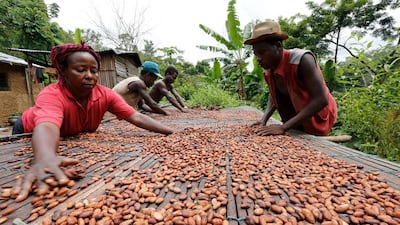Chocolate demand remained strong throughout the pandemic as the world's most popular comfort food was one of the pleasures continued to enjoy from their own homes.
The farmers who grow precious cocoa, however, saw little benefit.
Cocoa is the essential ingredient of chocolate and has no substitute. More than 70 per cent of the world's supply of cocoa comes from West Africa, according to Netherlands-based industry monitor Cocoa Barometer.
Of this, half comes from just two countries – Ghana and Ivory Coast. Other regional countries such as Nigeria and Cameroon are also expanding production, keen to grab a slice of the market that supplies the $130 billion chocolate industry.
“Cocoa has been an important commodity for our country,” says Hajia Maria Adamu-Zibo, the chief executive of Federated Commodities, a Ghana-based cocoa trader. The company is one of a growing number of local firms moving into an industry traditionally dominated by offshore companies from the US and Europe.
“Cocoa is not just a cash crop for us; it has also become part of our politics. The cocoa sector feeds about 800,000 people in the country and issues that affect the industry can be quite emotive.”
Just how emotive it can be was demonstrated in December, when US confectionary company Hershey’s enraged the primary suppliers in Ghana and the Ivory Coast, when it purchased a large quantity of cocoa through ICE Futures, a New York-based commodity exchange.
As one of the world’s largest confectionary producers, Hershey’s would usually purchase directly through West African in-country brokers. This time it went outside the usual channels, it is said, because it wanted to avoid a $400 surcharge these countries recently started to impose.
The ‘Living Income Differential’ (LID) as the surcharge is called, is paid directly to farmers, and is intended to increase their incomes. Farmers, who typically earn half a dollar a day over a 12-month period, would see their returns boosted by a third, thanks to the LID.
“Any brand that is seen not to be serious in accepting the LID by mid-December 2020 must consider all its cocoa beans from Ghana and Cote d’Ivoire as conventional,” Joseph Aidoo, chief executive of Ghanaian regulator Cocobod. told the World Cocoa Foundation's conference in November.
By ‘conventional’, Mr Aidoo was referring to the various certifications coveted by confection makers, that declare their products are sourced from exploitation-free farms, that do not use child labour, or contribute to deforestation. “We are prepared to name and shame these brands,” he said.
Certifications are increasingly important to consumers, especially younger, more socially-conscious chocolate buyers. Exploitation-free productions command a premium, and so Hershey’s quickly caved and said it would pay the LID.
Cargill, the US food and agricultural trader, published a study in December that shows consumers are happy to pay a premium for ethically-sourced cocoa.
“Consumer expectations are higher now than ever before,” says Niels Boetje, managing director Cocoa at Cargill.
Among 18-to-34-year-olds, 76 per cent of those polled by Cargill said sustainability has become more important to them in the past year when choosing chocolate products.
Just over half of these also declared they were swapping conventional products for those deemed to be ethical, even if they cost more. “Our research suggests that increasingly, consumers look for responsibly-sourced brands.”
The $400 LID supplements the $1,400 or so that farmers earned per ton, over the last season. This puts farmers’ earnings per ton over $1,800, meaning the farm gate price is closer to the $2,500 per ton cocoa currently fetches on international commodities exchanges.
It is hoped the LID will also spur demand for workers. A typical grower uses two acres of land, according to the Cocoa Barometer, and produces half a ton of beans a season. The land needs to be kept clear of weeds and other growth, with trees pruned and replanted, if necessary.
“Cocoa is labour-intensive, and we have a lot of unemployed people in Ghana,” says Nelson Kpodo-Tay, operations director at Armajo Ghana, a cocoa trading house based in the capital, Accra. The larger the acerage, the more workers are needed, which put farmers in a bind. “Labour costs around 200 cedis ($34.06) to work one acre. Bigger farms mean more cost.”
The 28 per cent increase in income delivered by the LID will go a long way to making extra labour more affordable, Mr Kpodo-Tay notes.
For now, most major confectioners including Mars, Nestle and Barry Callebaut have fallen in line to support the LID. Both Ghana and Ivory Coast insist it is here to stay.
The newly re-elected president of Ghana, Nana Akufo-Addo made the LID a central plank of his campaign strategy that swept him to victory last month. Sworn in for his second term on January 7, Mr Akufo-Addo says it will change the Ghanaian agriculture sector for good.
“The LID has been in the air for some time,” he told local broadcast station OkayFM, shortly before the elections. “It’s now implemented, and it is going to be part of the cocoa pricing policy for Ghana and Ivory Coast. It’s taken some time, but now the policy is working.”

